 More and more car owners are lending a hand and trying to carry out some repairs on their own . Which is understandable, because after all, you only pay for the spare parts and can save the costs for the workshop.
More and more car owners are lending a hand and trying to carry out some repairs on their own . Which is understandable, because after all, you only pay for the spare parts and can save the costs for the workshop.
Conveniently, there are the so-called do-it-yourself workshops, where you can rent a lifting platform cheaply and even the right tools for it. Which can make repairs a lot easier.
An important point, which must not be forgotten, is occupational safety. There are many rough edges, especially when it comes to car repairs.
Make sure you have enough freedom to work
Before repairs can even start, sufficient freedom to work should first be ensured. There is nothing worse than things that are lying around everywhere they don’t belong and that can possibly also become a trip hazard.
Therefore, a professional car workshop is always tidy and everything has its designated place.
Protect your hands from dirt
Repairs can quickly become a mess, but that’s not surprising. Brake dust, oil , grease and dirt from road traffic stick to many car parts. Not all of us like to have this dirt on our hands. It can sometimes take days until the dirt is completely removed and your hands are clean again.
You can protect yourself from this with work gloves. Gloves made of nylon with a PU coating are very suitable for this. These are non-slip and fit snugly on the hands. Which in turn ensures a good grip and a better sense of touch.
I myself have often bought professional work gloves from engelbertstrauss and have always been very satisfied with their quality. The specialist in occupational safety offers gloves for a wide variety of tasks, which on the one hand offer protection and at the same time do not restrict mobility and the sense of touch. There are also work gloves to buy in hardware stores.
Always wear sturdy shoes
Sandals, flip flops or clogs should be avoided. Sturdy shoes are the order of the day. Which should actually be a matter of course. But it cannot be stressed enough. Sensible shoes not only ensure a firm footing, they also protect against bruises.
For example, it makes a clear difference whether when you remove a tire it falls onto the shoe through carelessness and a large part of the material built into the shoe absorbs the weight, or whether the full weight acts on the teeth because you are wearing sandals.
My tip: sensible work shoes with steel toecaps are available in many hardware stores for as little as 19.99 euros. It’s an investment that pays off. Especially since the shoes can also be used for gardening.
 Wear a face mask and safety glasses
Wear a face mask and safety glasses
If an area of the car is being sanded and then painted, it is highly recommended that you always wear a face mask. If something is flexed, protective goggles should not be missing to protect yourself from flying sparks.
Use quality tools
You can choose the cheapest products when buying tools or you can invest a little more money and choose tools with a higher quality.
At first glance, the inexpensive tool is of course very tempting, because after all it seems to be able to perform the same tasks as more expensive products.
It is therefore not surprising that many people turn to the inexpensive product. However, my recommendation is to spend a little more money and invest it in quality, this approach always pays off in the long term.
With regular use, the cheap products always show why they are so cheap. Wear and tear can be observed, especially with tools (ring spanners, screwdrivers, sleeves, etc.), which are exposed to increased force, and at some point the point comes where they become unusable and a new purchase is necessary.
…



 If your car is driving and not causing any major problem, then there is really no reason to sell it. With regular maintenance and care and a sensible driving style, a car can drive many hundreds of thousands of kilometers. It doesn’t matter which model or make of car it is.
If your car is driving and not causing any major problem, then there is really no reason to sell it. With regular maintenance and care and a sensible driving style, a car can drive many hundreds of thousands of kilometers. It doesn’t matter which model or make of car it is. Cheaper insurance and taxes are possible
Cheaper insurance and taxes are possible